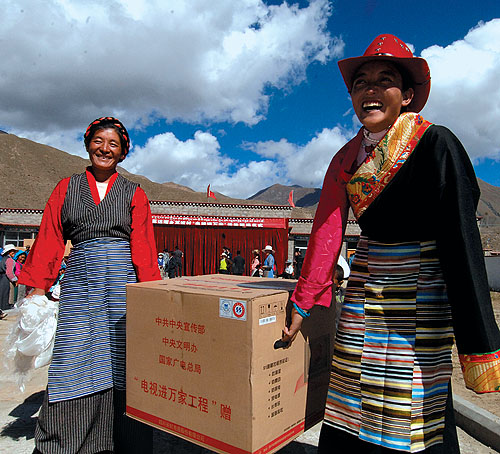|
In 2007, the TAR government continued supporting the development of cultural undertakings vigorously, giving emphasis to the public cultural undertakings to vitalize cultural development. A total of 710 million Yuan was spent on culture and press publication, an increase of 50.17 percent over the previous year. At the end of 2007, Tibet had 28 professional art performing groups, 203 cultural centers, four public libraries and two museums. There were also 18 folk art performing groups at county level and 500-odd amateur performing groups. The region has many large-scale cultural activities, including the annual Shoton Festival in Lhasa, Qomolangma Cultural and Tourist Festival in Xigaze and Summer Horse Race in Nagqu. They have become regional brand-name cultural and celebratory activities.
Radio, TV and Network
In recent years, Tibet has practically improved the audio-visual cultural life of farmers and herders. At the end of 2007, the region had three radio stations, 38 short and medium wave broadcasting transmitting stations and five TV stations, with the radio and TV coverage rate reaching 85.8 percent and 86.9 percent respectively, basically realizing the target of extending broadcasting coverage to each administrative village. Currently, an average of 1.6 films are projected monthly in each rural village; there is round-the-clock broadcasting via Tibetan Satellite TV.
 The Central Government energetically supports the development of the cultural undertakings in Tibet. Part of the project is to move TV sets to all families.
The Central Government energetically supports the development of the cultural undertakings in Tibet. Part of the project is to move TV sets to all families.
Furthermore, by the end of 2007, the number of internet subscribers in Tibet stood at 160,000, accounting for 5.8 percent of the population; this was 74,000 more than in January 2004. With regard to the location of website domain name registration units, the number of Tibetan domain names hit 2,440, compared to 1,616 in 2004.
Press and Publication
In 2007, centering on key selected topics such as tourism, Tibetan medicine, Tibetan handicrafts and animals and plants on the plateau, the press and publications department of Tibet realized sustainable, fast, healthy and orderly development. It published 84.358 million newspapers, a rise of 50.6 percent over the previous year; 3.903 million magazines, up 45 percent; and 11.919 million books, registering an increase of 28.6 percent. It soundly satisfied the readers of all ethnic groups and circles in the society.
|
